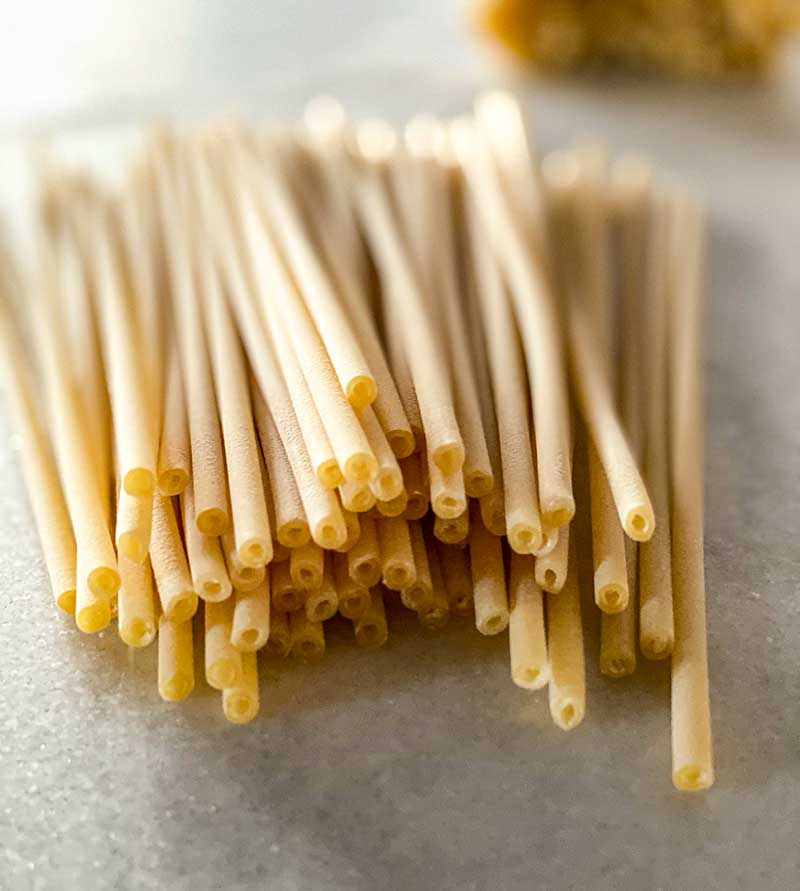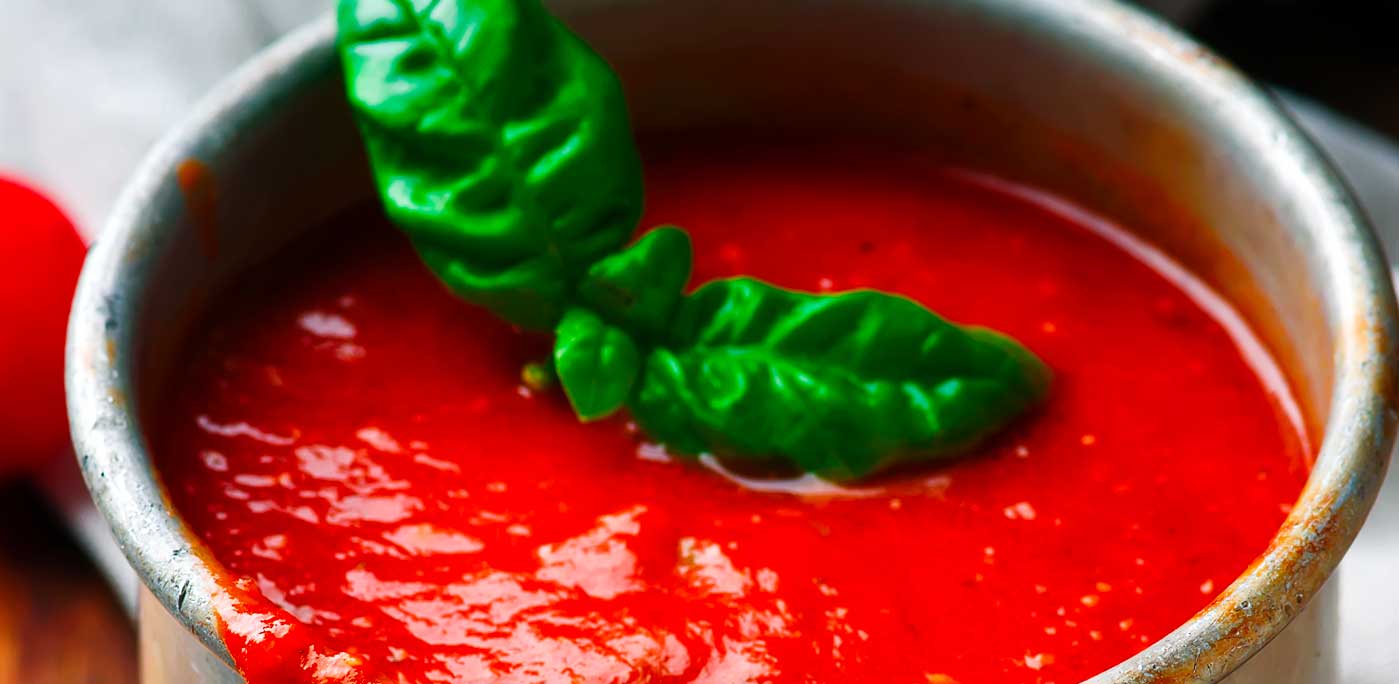The year was 1921, the place Ellis Island. My maternal grandmother, single, arrives into port from Napoli on the ship Patria to be with her sister Concetta, living in Brooklyn. My grandfather, who had come to America in 1911 from Marche, had recently lost his young wife to the 1918 flu epidemic and needed a mother for his then 5-year-old son Nelson. They somehow found each other in the sea of Italian immigrants that had arrived in the new world. They married in 1924.
My grandmother, Maria, grew up on the beautiful Bay of Naples. My grandfather told her he too lived on the water here in America. However, his body of water was the Delaware River that divides NJ and Pennsylvania, a far cry from the immense beauty of bays in Italy. She told that story often, with a chuckle.
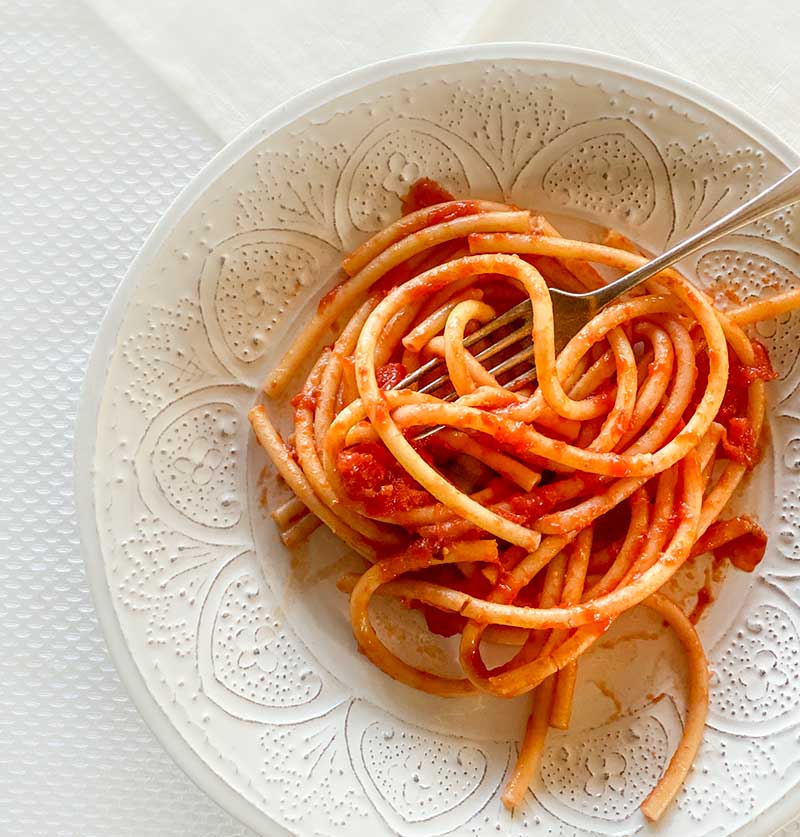
Good pasta, tomato sauce and a perfect result is guaranteed (Copyright: Michele Becci)
Together, they made it work – they went on to have 3 children together (my father the middle child) and they died within a year of each other in the late 60s.
The food of Naples is the food of our childhood — from the pasta and sauce my mother made every Sunday to the pasta fazool she had waiting for us after a cold winter’s walk home from school.
The soil in Campania specifically around the infamous volcano, Vesuvius, is incredibly fertile. Waverley Root in his The Food of Italy, states that legend has it Neapolitan sailors first brought the seeds of the tomato from Peru and they grew healthy and robust in the rich soil of Naples.
Today, the San Marzano tomato reigns supreme. The Neapolitans make a very simple sauce made from canned San Marzanos, simmered for a brief period with a garlic-infused olive oil and basil – allowing the magical and pure taste of this beautiful variety of tomatoes to shine through.
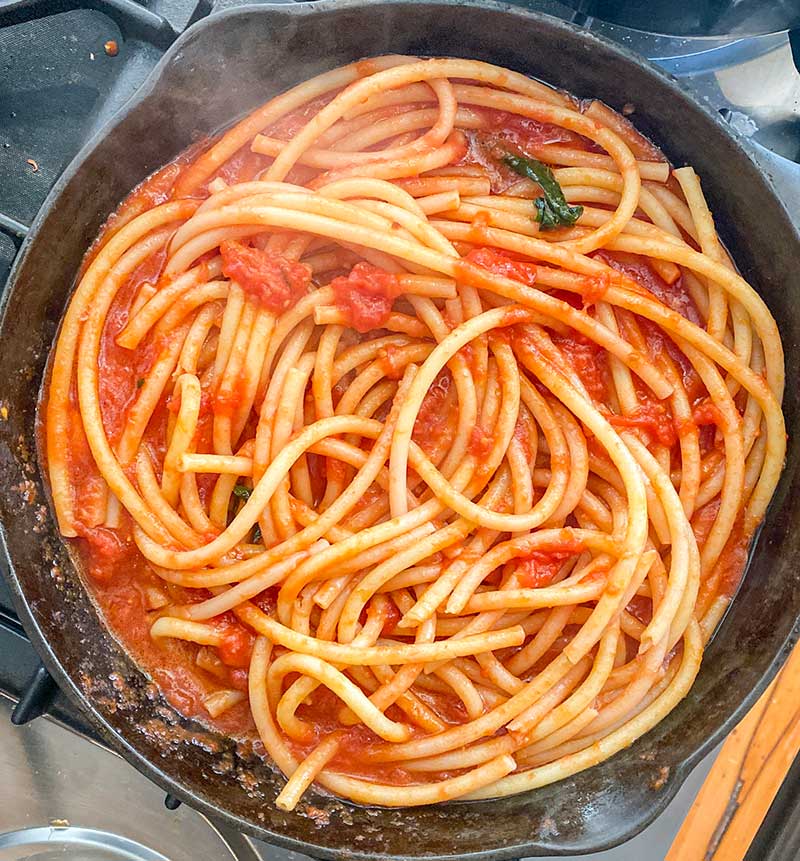
It’s important to finish cooking the pasta in the pan with the tomato sauce (Copyright: Michele Becci )
I don’t always use extra virgin olive oil to cook but in this case, given how few ingredients make up the sauce and their quality, I highly recommend breaking out the good stuff. Hot on the Neapolitan food trail, I purchased pasta from Neapolitan Pastificio Faella, established in 1907, turning out delicious pasta made from the wheat of Gragnano (the birthplace of Italian dried pasta) and the spring waters of the Lattari Mountains.
This sugo di pomodori is as easy as it comes – yet the ingredients, in their simplicity, allows the flavors of the tomatoes and the wheat to work their magic in your mouth. Seek out the ingredients if you can find them, open that bottle of vino, toss the dish together in under 30 minutes and enjoy these simple, magical pleasures from nature.
Buon appetito!
Michele
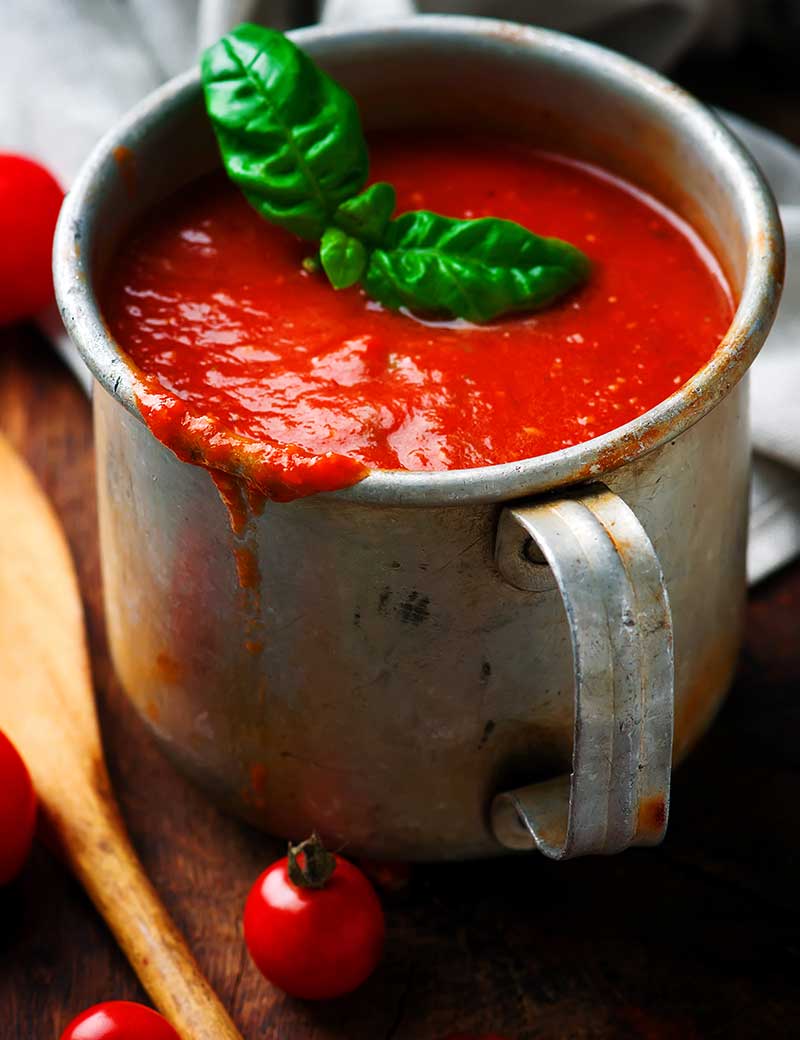
The beauty of traditional Neapolitan sugo di pomodori is its simplicity (Copyright: Dreamstime)
Neapolitan sugo di pomodori
Ingredients:
- 2 tablespoons extra virgin olive oil
- 2 or 3 medium cloves garlic, lightly smashed
- 1 (28-ounce) can San Marzano tomatoes
- A few leaves of basil
- Kosher salt
- Red pepper flakes
- Freshly ground black pepper
- Extra-virgin olive oil to finish
- 1 pound pasta (preferably made from Gragnano wheat)
Directions:
In a large saucepan or skillet (big enough to hold the pasta – I use my large cast iron skillet), warm the oil and the garlic cloves over medium low heat. Allow the garlic to slowly simmer in the oil until lightly browned on each side. Remove the garlic from the pan.
Raise the heat to medium. Add the can of tomatoes with their juice to the pan (some cooks like to drain the tomatoes which results in a thicker sauce. Either is fine). Add a few large pinches of salt to the sauce, a pinch of red pepper flakes and a few leaves of basil. Gently push on the tomatoes with a wooden spoon to break up them up in the sauce. Allow the sauce to simmer and thicken slightly.
Meanwhile, put up a large pot of salted water (like the sea!) to cook the pasta. Be at the ready to transfer the pasta into the sauce pan as you will only cook the pasta for a few minutes in the water. When it comes to a boil, drop in the pasta. Note how long the package says until al dente and only cook it for half that time in the water. Transfer the pasta to the sauce pan to finish cooking. For example, if the package says 8 minutes for al dente, transfer it to the sauce at around 4 minutes. Finish cooking the pasta to al dente in the sauce. Feel free to add a little bit of the pasta cooking water to the pan to further meld the flavors.
When ready, transfer the pasta to a heated serving bowl. Sprinkle with a few fresh basil leaves and a drizzle of extra virgin olive oil and serve!
Some Neapolitan’s would balk at serving grated cheese with this dish as it muddles its pure flavors, I say try it first without and add only if you feel you need to!
Era l’anno 1921, il posto era Ellis Island. Mia nonna materna, single, arriva in porto da Napoli sulla nave Patria per stare con sua sorella Concetta, che viveva a Brooklyn. Mio nonno, che era venuto in America nel 1911 dalle Marche, aveva recentemente perso la giovane moglie nell’epidemia influenzale del 1918 e aveva bisogno di una madre per figlio Nelson, allora di 5 anni. Si trovarono in qualche modo nel mare degli immigrati italiani che erano arrivati nel nuovo mondo. Si sposarono nel 1924.
Mia nonna, Maria, è cresciuta nella splendida baia di Napoli. Mio nonno le disse che anche lui viveva sull’acqua qui in America. Tuttavia, il corpo d’acqua di cui parlava era il fiume Delaware che divide NJ e Pennsylvania, ben lontano dall’immensa bellezza delle baie italiane. Lei raccontava spesso di quella storia, con una risatina.
Insieme, hanno fatto funzionare il matrimonio – hanno avuto 3 figli insieme (mio padre era il bambino di mezzo) e sono morti a un anno di distanza l’uno dall’altro alla fine degli anni ’60.
Il cibo di Napoli è il cibo della nostra infanzia – dalla pasta al sugo che mia madre faceva ogni domenica alla pasta fazool, la pasta e fagioli che in inverno ci faceva trovare dopo una fredda passeggiata di ritorno a casa da scuola.
Il terreno della Campania, in particolare quello intorno al famigerato vulcano Vesuvio, è incredibilmente fertile. Waverley Root nel suo Il cibo d’Italia, afferma che la leggenda narra che i marinai napoletani portarono per la prima volta i semi del pomodoro dal Perù e questi crebbero sani e robusti nel ricco suolo di Napoli.
Oggi, il pomodoro San Marzano regna sovrano. I napoletani preparano una salsa molto semplice a base di San Marzano in scatola, cotta a fuoco lento per un breve tempo con olio d’oliva, aglio e basilico – lasciando venire fuori il sapore magico e puro di questa bellissima varietà di pomodori.
Non sempre uso olio extravergine di oliva per cucinare ma in questo caso, visti i pochi ingredienti che compongono il sugo e la sua qualità, consiglio vivamente di tirare fuori l’olio migliore. A caldo sulla via dei cibi napoletani, ho acquistato la pasta dal napoletano Pastificio Faella, fondato nel 1907, ottenendo una deliziosa pasta fatta con il grano di Gragnano (il luogo di nascita della pastasciutta italiana) e le acque sorgive dei Monti Lattari.
Questo sugo di pomodori è facile come si presenta, e gli ingredienti, nella loro semplicità, permettono ai sapori dei pomodori e del grano di sprigionare la loro magia in bocca. Cercate gli ingredienti se riuscite a trovarli, aprite quella bottiglia di vino, mettete insieme il piatto in meno di 30 minuti e godetevi questi semplici e magici piaceri della natura.
Buon appetito!
Michele
Sugo di pomodori alla napoletana
Ingredienti:
– 2 cucchiai di olio extra vergine di oliva
– 2 o 3 spicchi d’aglio medio, leggermente schiacciato
– 1 (28 once) scatola di pomodori San Marzano
– Qualche foglia di basilico
– Sale kosher
– Fiocchi di peperoncino rosso
– Pepe nero appena macinato
– Olio extravergine di oliva per finire
– 1 libbra di pasta (preferibilmente di grano di Gragnano)
Istruzioni:
In una grande casseruola o padella (grande abbastanza per contenere la pasta – io uso la mia grande padella in ghisa), riscaldare l’olio e gli spicchi d’aglio a fuoco medio-basso. Lasciate cuocere lentamente l’aglio nell’olio fino a quando non sarà leggermente rosolato su ogni lato. Togliere l’aglio dalla padella.
Aumentare il calore a medio. Aggiungere la lattina di pomodori con il loro succo alla padella (alcuni cuochi scolano i pomodori cosa che si traduce in una salsa più spessa. Entrambe le cose vanno bene). Aggiungere qualche pizzico di sale alla salsa, un pizzico di scaglie di peperoncino e qualche foglia di basilico. Schiacciare delicatamente i pomodori con un cucchiaio di legno per spezzarli nella salsa. Lasciare sobbollire la salsa e farla addensare leggermente.
Nel frattempo, mettere su una grande pentola di acqua salata (come il mare!) per cuocere la pasta. Siate pronti a trasferire la pasta nella padella del sugo, perché la pasta si cuoce solo per pochi minuti in acqua. Quando bolle l’acqua, buttare la pasta. Controllare per quanto tempo deve cuocere sul pacchetto perchè sia al dente e solo per metà del tempo di cottura va fatto in acqua. Trasferire la pasta nella padella del sugo per terminare la cottura. Ad esempio, se la confezione dice 8 minuti perchè sia al dente, trasferitela nel sugo a circa 4 minuti. Terminare la cottura della pasta al dente nel sugo. Sentitevi liberi di aggiungere un po’ dell’acqua di cottura della pasta nella padella per fondere ulteriormente i sapori.
Quando è pronta, trasferite la pasta in una ciotola riscaldata. Cospargere con qualche foglia di basilico fresco e un filo d’olio extra vergine d’oliva e servite!
Qualche napoletano protesterebbe se si servisse il formaggio grattugiato con questo piatto in quanto confonde i suoi sapori puri, io dico di provarlo prima senza e aggiungerlo solo se ne avete bisogno!

